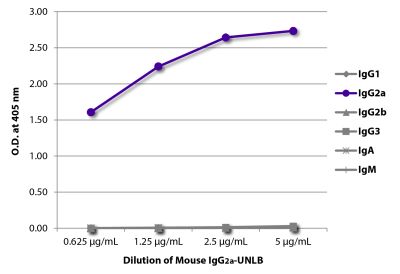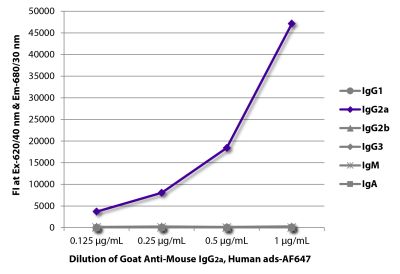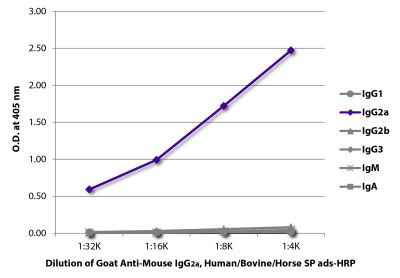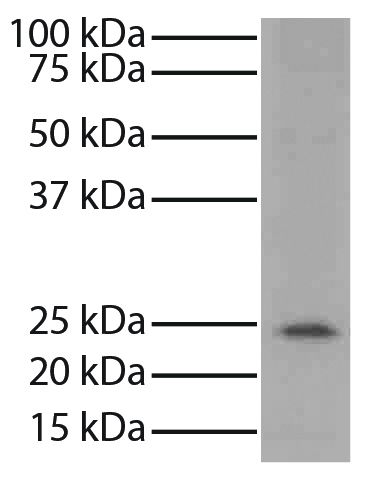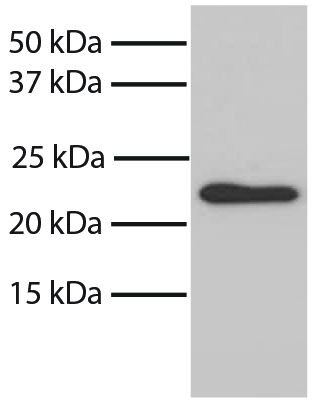Mouse Anti-Bcl-xL-UNLB (2H12)
Cat. No.:
10035-01
Purified Anti-Bcl-xL antibody for use in flow cytometry, immunohistochemistry, ELISA, western blot, and immunoprecipitation assays.
$215.00
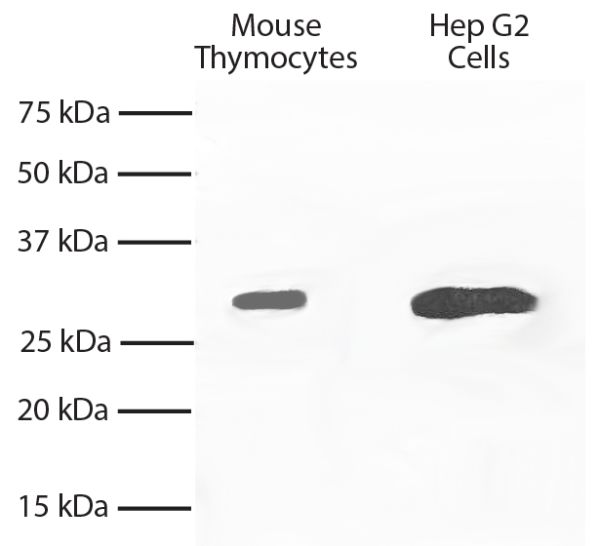

| Clone | 2H12 |
|---|---|
| Isotype | Mouse IgG2aκ |
| Isotype Control | Mouse IgG2a-UNLB (HOPC-1) |
| Specificity | Mouse/Rat/Human Bcl-xL |
| Alternative Names | Apoptosis regulator Bcl-X, Bcl-2-like 1 protein, BCL2L1 |
| Description | Bcl-xL is a 29 kDa member of the Bcl-2 family of proteins that has been shown to block apoptosis. The monoclonal antibody 2H12 reacts with an N-terminal epitope between amino acids 3-14 that is common to mouse, human, and rat Bcl-xL. |
| Immunogen | Bcl-xL peptide (a.a. 3-14) common to mouse and human |
| Conjugate | UNLB (Unconjugated) |
| Buffer Formulation | Borate buffered saline, pH 8.2 |
| Clonality | Monoclonal |
| Concentration | 0.1 mg/mL |
| Volume | 1.0 mL |
| Recommended Storage | 2-8°C |
| Applications |
Western Blot – Quality tested 1-7 Immunoprecipitation – Reported in literature 6,8 Flow Cytometry – Reported in literature 5,7,9 Immunohistochemistry-Paraffin Sections – Reported in literature 4,10,11 ELISA – Reported in literature 12 |
| RRID Number | AB_2794105 |
| Gene ID |
12048 (Mouse) 24888 (Rat) 598 (Human) |
| Gene ID Symbol |
Bcl2l1 (Mouse) Bcl2l1 (Rat) BCL2L1 (Human) |
| Gene ID Aliases | Bcl(X)L; Bcl-XL; Bcl2l; BclX; bcl-x; bcl2-L-1; Bcl-xl; Bclx; bcl-X; BCL-XL/S; BCL2L; BCLX; Bcl-X; PPP1R52 |
| UniProt ID |
Q64373 (Mouse) P53563 (Rat) Q07817 (Human) |
| UniProt Name |
B2CL1_MOUSE (Mouse) B2CL1_RAT (Rat) B2CL1_HUMAN (Human) |
Documentation
Certificate of Analysis Lookup
Enter the Catalog Number and Lot Number for the Certificate of Analysis you wish to view
- 1. Hsu Y, Youle RJ. Nonionic detergents induce dimerization among members of the Bcl-2 family. J Biol Chem. 1997;272:13829-34. (Immunogen, WB)
- 2. Hsu Y, Wolter KG, Youle RJ. Cytosol-to-membrane redistribution of Bax and Bcl-XL during apoptosis. Proc Natl Acad Sci USA. 1997;94:3668-72. (WB)
- 3. Wolter KG, Hsu Y, Smith CL, Nechushtan A, Xi X, Youle RJ. Movement of Bax from the cytosol to mitochondria during apoptosis. J Cell Biol. 1997;139:1281-92. (WB)
- 4. Chu W, Aguilera NS, Wei MQ, Abbondanzo SL. Antiapoptotic marker Bcl-XL, expression on Reed-Sternberg cells of Hodgkin's disease using a novel monoclonal marker, YTH-2H12. Hum Pathol. 1999;30:1065-70. (WB, IHC-PS)
- 5. Ferrero E, Belloni D, Contini P, Foglieni C, Ferrero ME, Fabbri M, et al. Transendothelial migration leads to protection from starvation-induced apoptosis in CD34+CD14+ circulating precursors: evidence for PECAM-1 involvement through Akt/PKB activation. Blood. 2003;101:186-93. (WB, FC)
- 6. Jeong S, Gaume B, Lee Y, Hsu Y, Ryu S, Yoon S, et al. Bcl-xL sequesters its C-terminal membrane anchor in soluble, cytosolic homodimers. EMBO J. 2004;23:2146-55. (WB, IP)
- 7. Dodson LF, Boomer JS, Deppong CM, Shah DD, Sim J, Bricker TL, et al. Targeted knock-in mice expressing mutations of CD28 reveal an essential pathway for costimulation. Mol Cell Biol. 2009;29:3710-21. (WB, FC)
- 8. Pérez-Galán P, Roué G, Villamor N, Campo E, Colomer D. The BH3-mimetic GX15-070 synergizes with bortezomib in mantle cell lymphoma by enhancing Noxa-mediated activation of Bak. Blood. 2007;109:4441-9. (IP)
- 9. Boomer JS, Deppong CM, Shah DD, Bricker TL, Green JM. Cutting edge: A double-mutant knockin of the CD28 YMNM and PYAP motifs reveals a critical role for the YMNM motif in regulation of T cell proliferation and Bcl-xL expression. J Immunol. 2014;192:3465-9. (FC)
- 10. Hyjek E, Chadburn A, Liu YF, Cesarman E, Knowles DM. BCL-6 protein is expressed in precursor T-cell lymphoblastic lymphoma and in prenatal and postnatal thymus. Blood. 2011;97:270-6. (IHC-PS)
- 11. Aebersold DM, Kollar A, Beer KT, Laissue J, Greiner RH, Djonoz V. Involvement of the hepatocyte growth factor/scatter factor receptor c-met and of Bcl-xL in the resistance of oropharyngeal cancer to ionizing radiation. Int J Cancer. 2001;96:41-54. (IHC-PS)
- 12. Hackett GS. Intracellular delivery of therapeutic antibodies [dissertation]. Nottingham (United Kingdom): University of Nottingham; 2011. (ELISA)
See More


